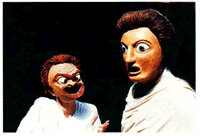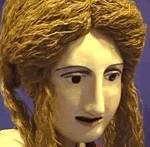 
Unit
2 - Theatre History
Module
2: Jesters, Tricksters and Fools
Lesson
2 - Commedia del Arte
Introduction:
The
purpose of this lesson is to become familiar with (and experiment
with) the commedia style.
 |
Who
are some of your favorite comedians? What is it that makes
them funny - physical stuff, social commentary, risqué
material? In laughing at them, are we also laughing at ourselves
and others we know? |
  
Activities:
Activity
1- Warm Up:
"Everybody's
It"
This
is a good energy boosting game of tag. Everybody is it all at
the same time. Yell 'go' and then try to tag others while not
being tagged yourself. Tagging can only happen on the back.
It works best in a fairly large, yet contained area.
* variation: when tagging call out the name of an animal, the
person tagged must stand and make the animal noise until "freed"
by a hug.
"Yes, Let's"
You
begin by walking about the room in a random pattern. At any
point, anyone can call out an instruction -"Let's all crow
like roosters", and everyone must respond "Yes, Let's!"
and then must continue crowing until a new instruction is called.
Let the game continue with lots of suggestions.
Activity
2 - Mask Monologue:
Read
the background information on the masks and the notes page on
Commedia dell 'Arte. Form groups of 3 to 5 people and work together
to prepare a summary of the notes (in your own words) and write
a description of one of the masks as seen on the related sites
(below).
Using the
mask as an inspiration for the character, the group improvises
a scene suitable for the character. The scene must set up an
opportunity for a monologue (perhaps in the form of an aside
to the audience). After you have completed the improv, summarize
the scene in writing and turn it in to the teacher with the
mask description and summary of notes.

This image shows two examples of the reconstructed masks,
a Slave and a Young Man. These are typical characters
from Menander's plays. |
"The
reconstructions are based on the appearance of the original
masks as shown by artifacts, mainly small models or masks
used as motifs in the decoration of pottery or sculpture.
There are no known surviving examples of the original
masks used in (Commedia del Arte) performances.
The aims of the project are to show what the original
masks might have looked like and to produce a set of masks
that can be used in performances of plays by Menander,
the only New Comedy playwright whose works survive. "
(Chris
Vervain copyright 2001)
|
|
This
image shows a mask designed to be suitable for a female
character from Menander, possibly a hetaera.
View
the web site: Chris Vervain - "Mask
Theatre"
(Chris
Verain, copyright 2001)
|
|
Activity 3 - Commedia Scene:
Create your own Commedia type scenes using the characters in modern
settings. Use masks (if available), or a simple costume piece
to denote characters. Use the same small groups of three to five
from the previous assignment. Select from the table below to choose
characters and improvisational scenarios:
|
Characters
|
Scenarios
|
|
Masters:
Pantalone
(old, crude, greedy, paranoid and of limited intelligence)
Gratiano (usually a miserly lawyer, called vecchi)
Capitano
(a blustering Spanish captain who is afraid of his own
shadow)
Servants:
Pedrolino and Arlecchino (Harlequin) are clever,
quick and always looking to trick the master (they are
called zanni)
1st Zany (a male servant who was a clever rogue
often plotting against the masters)
2nd Zany (a stupid male servant caught up in the
1st Zany's plans and ends up a victim of his pranks)
3rd Zany (a female servant who would participate
in schemes and provide a romantic story among the servants)
Lovers:
(in love, called amarosi)
|
i)
A local restaurant, customers and employees, trying
to place an order - no one has any brains at all.
ii)
At the scene of an minor auto accident, arguing over
who is to blame, the police arrive.
iii)
A scene about love and mistaken identity.
iv)
A scene about greed and trickery.
v)
At a work site on a highway project, in which no work
ever seems to get accomplished.
vi)
At a political rally, trying to win votes and gather
donations for the party.
vii)
Try a scene with a lazzo - a piece of stage business
with juggling, singing or acrobatics - which was once
a regular part of an actor's repertoire. (See Lesson
4 in this module for juggling instruction.)
|
Evaluation:
You are evaluated based on your group's interpretation of
the comedy style. Read the
evaluation sheet before beginning the assignments.
Next
Lesson /Previous Lesson
|









